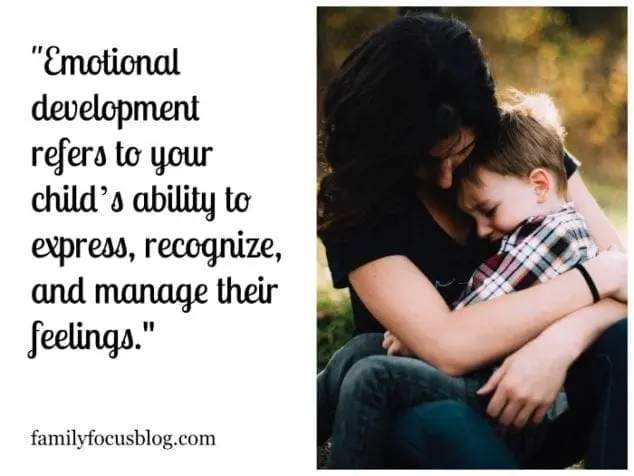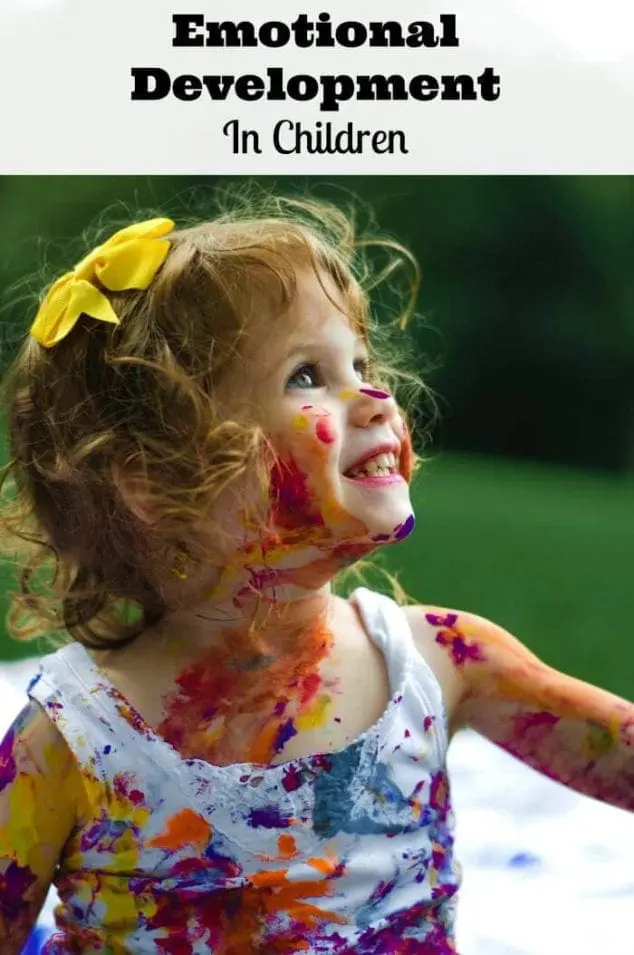Knowing what emotion we are experiencing and why we are experiencing it is not a given. As an adult, it can be easy to forget that. As a parent, we often run into sharp reminders of this with toddlers who can seem so unreasonable. A child’s tantrums or outbursts generally happen when they don’t manage their emotions. Emotional development in children is a very important aspect to their learning process. We’ll go into depth here on what emotional development really means and how you can help your child obtain new skills in emotional learning. This social-emotional growth will help develop a child’s emotional regulation abilities as well.

What is Emotional Development?
Emotional development refers to your child’s ability to express, recognize, and manage their feelings at different stages of their growth. It’s about learning to understand and express both positive and negative emotions. Kids need to feel safe to do this within their relationships, especially with parents, siblings, and friends.
Social emotional development refers to the process through which individuals, particularly children, acquire the ability to understand, express, and manage their emotions, as well as develop the capacity to establish positive relationships with others. It encompasses several key areas:
- Self-Awareness: Understanding one’s own emotions, strengths, weaknesses, values, and motives.
- Self-Management: Regulating one’s emotions, thoughts, and behaviors in different situations; managing stress, controlling impulses, and motivating oneself.
- Social Awareness: Showing understanding and empathy for others; recognizing and appreciating individual and group differences.
- Relationship Skills: Establishing and maintaining healthy and rewarding relationships based on cooperation; resisting inappropriate social pressure; negotiating conflict constructively.
- Responsible Decision-Making: Making ethical, constructive choices about personal and social behavior.
Emotional Development Milestones
Infants as young as six weeks begin to show emotion with family members. They use smiles and accompanying sounds of happiness. By the time they’re around three months old, they start learning to laugh. This shows they can recognize an action outside of the norm and respond accordingly.
Emotional development improves and their responses become more strong as they grow. Young toddlers learn to express happiness, frustration, and sadness. And more importantly, they learn to express these emotions at the appropriate time in response to what’s happening around them.
As children practice imitating adults and have more social interactions with peers, their emotional development continues. At about the time they start kindergarten, children are experiencing more complex feelings like embarrassment. They are learning to express their feelings with words but often still struggling to do so. I remember trying to prompt my children, “Leo, use your words, and tell me what you are feeling.” You can read more on what to expect at different ages here.

Emotional Development In Early Childhood
Having appropriate emotional skills becomes important to children throughout their life and it can impact how they interact and function in the world around them even as adults. A positive relationship with adults they trust is key to the success of emotional developmental in children. Emotional development in early childhood is often about imitation of the adults who are close and the response children get as they display different emotions.
Here are key aspects and milestones of emotional development during this stage:
Infancy (0-2 years)
- Attachment Formation: Infants form strong emotional bonds with their primary caregivers. Secure attachment is crucial for later emotional health.
- Basic Emotions: Infants express basic emotions such as joy, anger, sadness, and fear.
- Social Smiles: Around 6-8 weeks, infants begin to smile in response to social interactions.
- Stranger Anxiety: Around 8-9 months, infants may show fear and wariness of strangers, indicating the development of strong attachment bonds.
- Separation Anxiety: Infants may become distressed when separated from their primary caregiver, typically peaking around 12-18 months.
Toddlerhood (2-3 years)
- Self-Awareness: Toddlers start to develop a sense of self, recognizing themselves in mirrors and photos.
- Emotional Expression: Toddlers express a wider range of emotions and begin to understand and label their feelings.
- Temper Tantrums: Common as toddlers struggle with frustration and developing self-control.
- Empathy Emergence: Toddlers start to show early signs of empathy, like comforting a crying peer or offering to share toys.
- Imitation of Emotions: Toddlers imitate the emotional expressions of those around them, learning to understand and replicate social cues.
Preschool Years (3-5 years)
- Understanding Emotions: Preschoolers can better understand their own and others’ emotions and begin to recognize that others may feel differently than they do.
- Emotional Regulation: Children start to learn strategies for managing their emotions, such as seeking comfort from a caregiver or using language to express feelings.
- Empathy and Compassion: Enhanced ability to empathize with others and show compassionate behavior.
- Complex Emotions: Development of more complex emotions like pride, guilt, and shame.
- Social Play: Engaging in cooperative play, which helps in learning social rules and norms, turn-taking, and conflict resolution.
What can you do to help your child’s emotional development along?
Developing these social emotional skills is crucial for personal well-being and success in social, academic, and professional environments. Social-emotional development begins in early childhood and continues through adulthood, influenced by interactions with caregivers, peers, teachers, and the broader community.
Model appropriate behaviors
Model appropriate behaviors for them and let them learn by your example. Infants and toddlers especially learn from watching the people around them. They will often mimic facial expressions as well as verbal expressions.
Be affectionate
Be affectionate with your child. Hugs, kisses, and snuggles will help them feel safe and will teach them emotional skills. Offering a positive response when your child shares their feelings, teaches emotions are natural and helps them learn to regulate their behavior. Showing acceptance instead of immediately rejecting your child’s emotions, helps them to repeat this process of identifying and working through their big feelings.
Express Feelings
Ask them to express what they’re feeling in words so that they can learn to understand and identify how they’re feeling. Start with the basics of happy, mad, or sad and add as appropriate. Be considerate of their feelings, wants, and needs so that they can learn to understand the appropriate responses to what they’re feeling.
Ask them about their day, their activities, and how they felt throughout the day while doing things they enjoyed. This is part of how they learn to express emotions in positive ways during the early years.
Offer Encouragement
Show pride in their accomplishments, both big and small. A child’s need to feel pride is a major motivator in their decisions and actions.
Offer encouragement and support when they need it. This will help them understand and accept feelings and emotions they may not like as much and it will help them learn to deal with stress. And learning to deal with stress through appropriate coping mechanisms is a very important lesson for kids.
Encourage them to try new things so they can see what they’re capable of and learn new things they enjoy.
Problem-Solving Skills
Parents can teach children how to resolve conflicts and solve problems by guiding them through the process. This can involve discussing different solutions, considering others’ perspectives, and understanding the consequences of actions.
Provide Opportunities For Interaction
Provide opportunities for them to play with other children so they can learn to express and model emotional behaviors outside of their home environment and develop social skills as well.
Establish Flexible Routines
Establish routines so your child has some predictability they can count on, but also be flexible with those routines to help them learn how to adjust and become resilient.
You Set The Example
You are your child’s best role model as their emotional development grows and they begin to understand how to recognize and express their feelings. The most important thing you can do is provide encouragement in a safe and trusting environment to allow them the space to grow.
Conclusion
Social emotional development is a critical aspect of parenting, as parents play a foundational role in nurturing these skills in their children. As parents, children need out Emotional Support. Providing a supportive and loving environment helps children feel secure and valued. This emotional security is essential for children to explore and understand their own emotions. Furthermore, parents can encourage children to talk about their feelings and experiences. This helps children develop a vocabulary for their emotions and understand that it is okay to express how they feel. Clear, consistent boundaries and expectations help children learn self-regulation and responsibility. When parents enforce rules with empathy and explain the reasons behind them, children learn to manage their behavior better.
Emotional development in children should not be overlooked. Well developed social-emotional skills are something that will help them be more successful in adult life too. Your emotional intelligence or emotional quotient (EQ) is something that we can continue to work on refining as adults.
Related Posts:
Learning to Like the Child You Love
Encouraging Independence In Toddlers
The Smart Mom’s Guide to Emotional Intelligence
